Phytotoponyms, Geographical Features and Vegetation Coverage in Western Hubei, China
Abstract
:1. Introduction
2. Materials and Methods
2.1. Characteristics of the Study Area
2.2. Data Sources and Processing Methods
- Place name data: All of the toponyms used in this research were collected from the place names database of Hubei Province at the Civil Affairs Department of Hubei. We selected all of the mass self-organisation place names as statistical objects, which included all of the rural villager committee names and urban resident committee names. Because these places were named spontaneously by the community or were named based on geomorphic characteristics, surnames or other factors, smaller places are more likely reflect the local natural landscape than larger places. The place names data can be divided into phytotoponyms and non-phytotoponyms. This is not a common classification method, but that toponyms were classified into these two groups for the purpose of this research, which focuses on phytotoponyms. Phytotoponyms can be further divided into woody plant toponyms and herbaceous plant toponyms. We first chose phytotoponyms according to their literal meanings. We obtained all toponyms that contain the names of plants. However, a few of these toponyms were not phytotoponyms. We excluded the toponyms that share people’s surnames; for example, certain plant names are used as surnames in China, such as poplar (Yang), willow (Liu) and plum (Mei). Additionally, we excluded toponyms named for other factors, such as terrain, or misread names. Note that it was difficult to determine the true motivation behind the origin of certain toponyms in which plant names were recognised. Specifically, we considered that these particular toponyms were phytotoponyms. Finally, we obtained the toponyms that contain the names of plants and were named after plants, phytotoponyms. We randomly selected non-phytotoponyms in every county, and we ensured that equal numbers of phytotoponyms and non-phytotoponyms were selected. We counted the number of phytotoponyms, woody plant toponyms and herbaceous plant toponyms of every county and classified them to 5 levels (Table 2). The classification standards of the number of woody plant toponyms and herbaceous plant toponyms are same with phytotoponyms.
- Coordinate data: To obtain the coordinates for all toponyms, data were selected using Amap coordinates. However, a situation must be considered in which a particular toponym may appear in several counties. The coordinates can help provide the geographical features and NDVI characteristics where the toponyms are located. All of the toponyms were reduced to points in the process of obtaining the geographical features and NDVI characteristics.
- NDVI: To obtain the vegetation coverage of every location, the NDVI dataset of Western Hubei, with a spatial resolution of 250 m, was downloaded from the Computer Network Information Centre, Chinese Academy of Sciences (Beijing, China), at international scientific data mirror sites. We then used spatial analyst tools to extract values at a point in ArcGIS and obtain the grid value of each location. The vegetation coverage in the study area is presented in Figure 2. There is higher vegetation coverage rate in the western region of the study area than in the middle of the study area. We also obtained the average NDVI of every county. We used fNDVI to evaluate the vegetation coverage degree of every county [23], the formula of fNDVI is as follows:where NDVImin and NDVImax are the minimal and maximum NDVI of all the counties. The fNDVI value is between 0 and 1. We also classified fNDVI to 5 levels [24] and the standard presented in Table 2.
- Altitude, slope and aspect data: To obtain the altitude, slope and aspect data of each location, digital elevation models (DEMs), slopes and aspects of Western Hubei, with a spatial resolution of 90 m, were downloaded from the Computer Network Information Centre, Chinese Academy of Sciences, China, at international scientific data mirror sites. We obtained the grid value of each location using the same method described for the NDVI data. We also obtained the average altitude and slope of every county and classified them to five levels according to the standards [25,26]. The specific standards are presented in Table 2.
2.3. Statistical Analysis
2.4. Information Entropy Calculation
2.5. Technology Flow Chart
3. Results and Discussion
3.1. Linguistic Features of the Phytotoponyms
3.2. Geographical Distribution of the Phytotoponyms
3.3. The Relationship Between Topography and Phytotoponyms
3.4. The Relationship Between NDVI and Phytotoponyms
3.5. Correlation Analysis based on Information Entropy Theory
3.6. Estimating Long-term Vegetation Degradation Using Phytotoponyms
4. Conclusions
Acknowledgments
Author Contributions
Conflicts of Interest
References
- Encyclopedia of China: Geography Toponym; Encyclopedia of China Publishing House: Beijing, China, 1992.
- Kadmon, N. Toponymy: The Lore, Laws, and Language of Geographical Names; Vantage Press: New York, NY, USA, 2000. [Google Scholar]
- Pu, S.X. Theory and Application of Geographic Names Information System—Digital Names; Xinhua Publishing House: Beijing, China, 2000. [Google Scholar]
- Conedera, M.; Vassere, S.; Neff, C.; Meurer, M.; Krebs, P. Using toponymy to reconstruct past land use: a case study of ‘brüsáda’ (burn) in southern Switzerland. J. Hist. Geogr. 2007, 33, 729–748. [Google Scholar]
- Henshaw, A. Pausing along the journey: Learning landscapes, environmental change, and toponymy amongst the Sikusilarmiut. Arct. Anthropol. 2006, 43, 52–66. [Google Scholar]
- Ford, R.E.; Toponymic, Generics. Environment, and Culture History in Pre-Independence Belize*. Names 1991, 39, 1–26. [Google Scholar]
- Tucci, M.; Ronza, R.W.; Giordano, A. Fragments from many pasts: Layering the toponymic tapestry of Milan. J. Hist. Geogr. 2011, 37, 370–384. [Google Scholar]
- Alderman, D.H. Street names and the scaling of memory: The politics of commemorating Martin Luther King, Jr within the African American community. Area 2003, 35, 163–173. [Google Scholar]
- Horsman, S. The politics of toponyms in the Pamir Mountains. Area 2006, 38, 279–291. [Google Scholar]
- Yeoh, B.S. Street-naming and nation-building: Toponymic inscriptions of nationhood in Singapore. Area 1996, 28, 298–307. [Google Scholar]
- Wang, F.; Zhang, L.; Zhang, G.; Zhang, H. Mapping and spatial analysis of multiethnic toponyms in Yunnan, China. Cartogr. Geogr. Inf. Sci. 2014, 41, 86–99. [Google Scholar]
- Wang, F.; Wang, G.; Hartmann, J.; Luo, W. Sinification of Zhuang place names in Guangxi, China: A GIS-based spatial analysis approach. Trans. Inst. Br. Geogr. 2012, 37, 317–333. [Google Scholar]
- Guan, Y.B. Placename and Geographical Distribution of Nationality. J. Guizhou Norm. Univ. (Soc. Sci.) 2007, 3, 13–19. [Google Scholar]
- Seidl, N.P. Significance of Toponyms, with Emphasis on Field Names, for Studying Cultural Landscape. Acta Geogr. Slov. 2008, 48, 33–56. [Google Scholar]
- Wang, B.; Situ, S. Analysis of spatial characteristics of place names landscape based on GIS technology in Guangdong Province. Geogr. Res. 2007, 2, 238–148. [Google Scholar]
- Li, J.H.; Mi, B.W.; Feng, C.Y.; Yang, X.M. An analysis on toponym cultural landscape based on GIS application in Zhongwei county, Ningxia municipality. Hum. Geogr. 2011, 1, 100–104. [Google Scholar]
- Wang, B.; Yue, H. EOF Model Analysis of Place Names Landscape in Guangdong Province on GIS. Geogr. Sci. 2007, 2, 281–288. [Google Scholar]
- Čargonja, H.; Đaković, B.; Alegro, A. Plants and Geographical Names in Croatia. Coll. Anthr. 2008, 32, 927–943. [Google Scholar]
- Guarino, R. A survey of the botanical place names of the Iglesiente Area (south west Sardinia). Bot. Lith. 2007, 13, 139–157. [Google Scholar]
- Shannon, C.E. A Mathematical Theory of Communication. Bell Syst. Tech. J. 1948, 27, 379–423. [Google Scholar]
- Chen, X.X.; Hu, T.; Ren, F.; Chen, D.; Li, L.; Gao, N. Landscape Analysis of Geographical Names in Hubei Province, China. Entropy 2014, 16, 6313–6337. [Google Scholar]
- Hubei Provincial Development Strategic Planning Office. The charm of Western Hubei (in Chinese). Available online: http://www.exiquan.com.cn/ZX/mlexiquan.aspx accessed on 28 June 2014.
- Niu, B.R.; Liu, J.R.; Wang, Z.W. Remote Sensing Information Extraction Based on Vegetation Fraction in Drought and Half-Drought Area. Geomat. Inf. Sci. Wuhan Univ. 2005, 30, 27–30. [Google Scholar]
- Shi, T.T.; Chen, Z.H.; Wang, N.T.; Jin, X.W. Spatial correlation analysis on soil organic carbon and the influencing factors in the Xiangxi River Basin. Carsologica Sin. 2005, 30, 422–431. [Google Scholar]
- Li, B.; Pan, B.; Han, J. Basic terrestrial geomorphological types in China and their circumscriptions. Quat. Sci. 2008, 28, 535–543. [Google Scholar]
- The Land Use Updating Investigation Technical Regulations; Ministry of Land and Resources of the People’s Republic of China: Beijing, China, 2003.
- Zar, J.H. Biostatistical Analysis; Pearson Education India: Chennai, India, 1999. [Google Scholar]
- Lehmann, E.L.; D’Abrera, H.J. Nonparametrics: Statistical Methods Based on Ranks; Springer: New York, NY, USA, 2006; p. 464. [Google Scholar]
- Borda, M. Fundamentals in Information Theory and Coding; Springer: New York, NY, USA, 2011; Volume 6. [Google Scholar]
- Meyer, W.B.; Turner, B.L., II. Changes in Land Use and Land Cover: A Global Perspective; Cambridge University Press: Cambridge, UK, 1994; Volume 4. [Google Scholar]
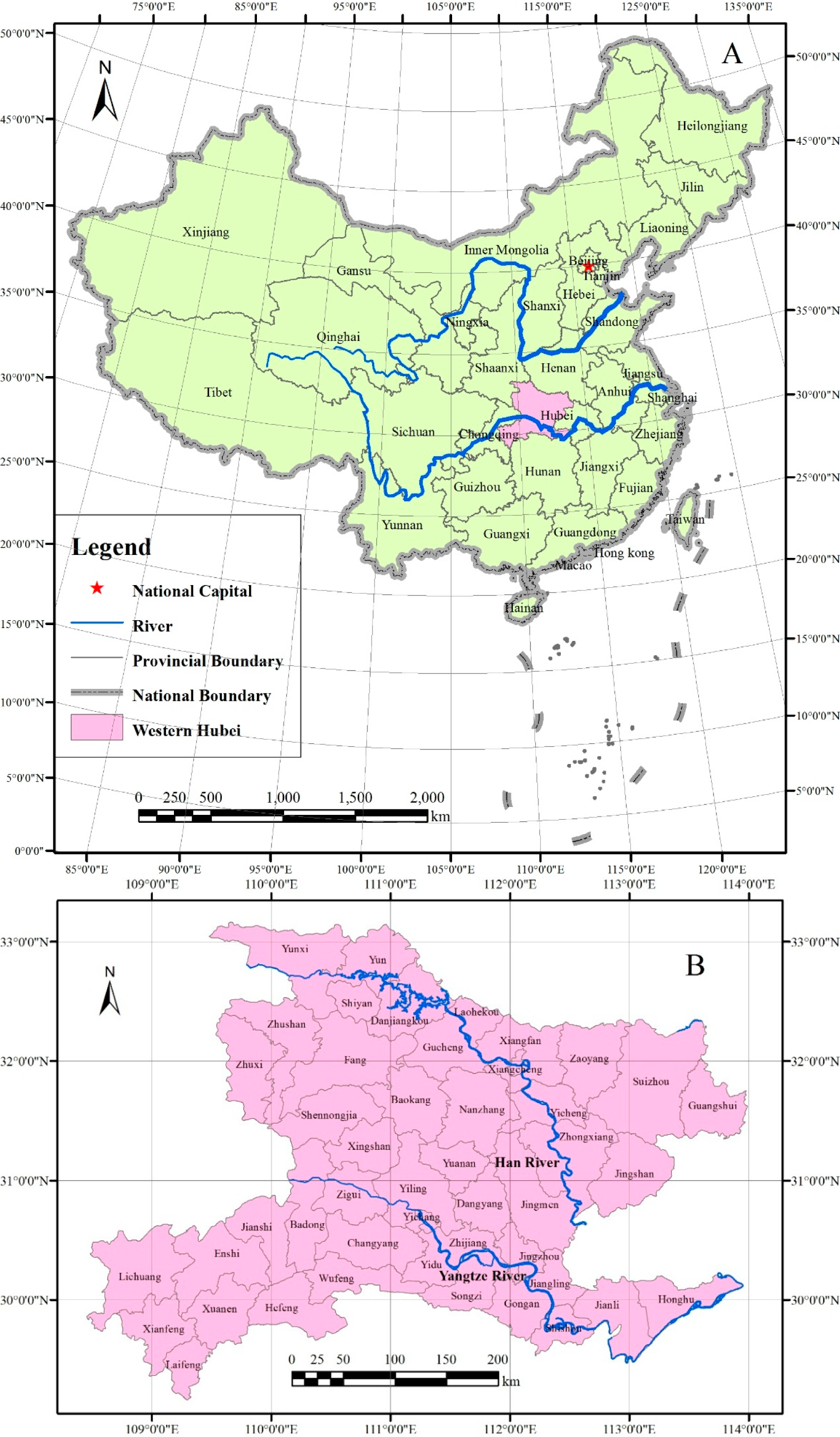
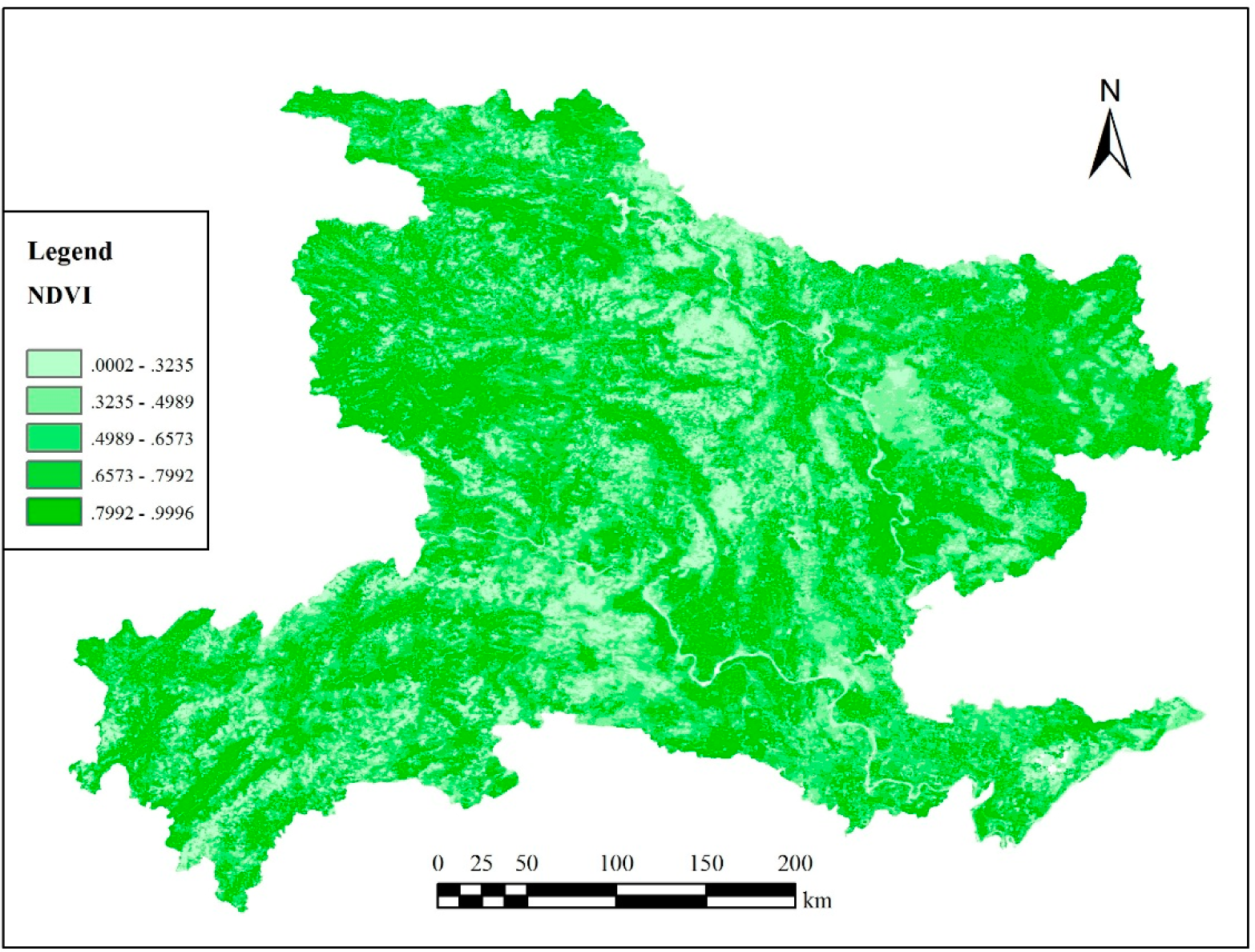
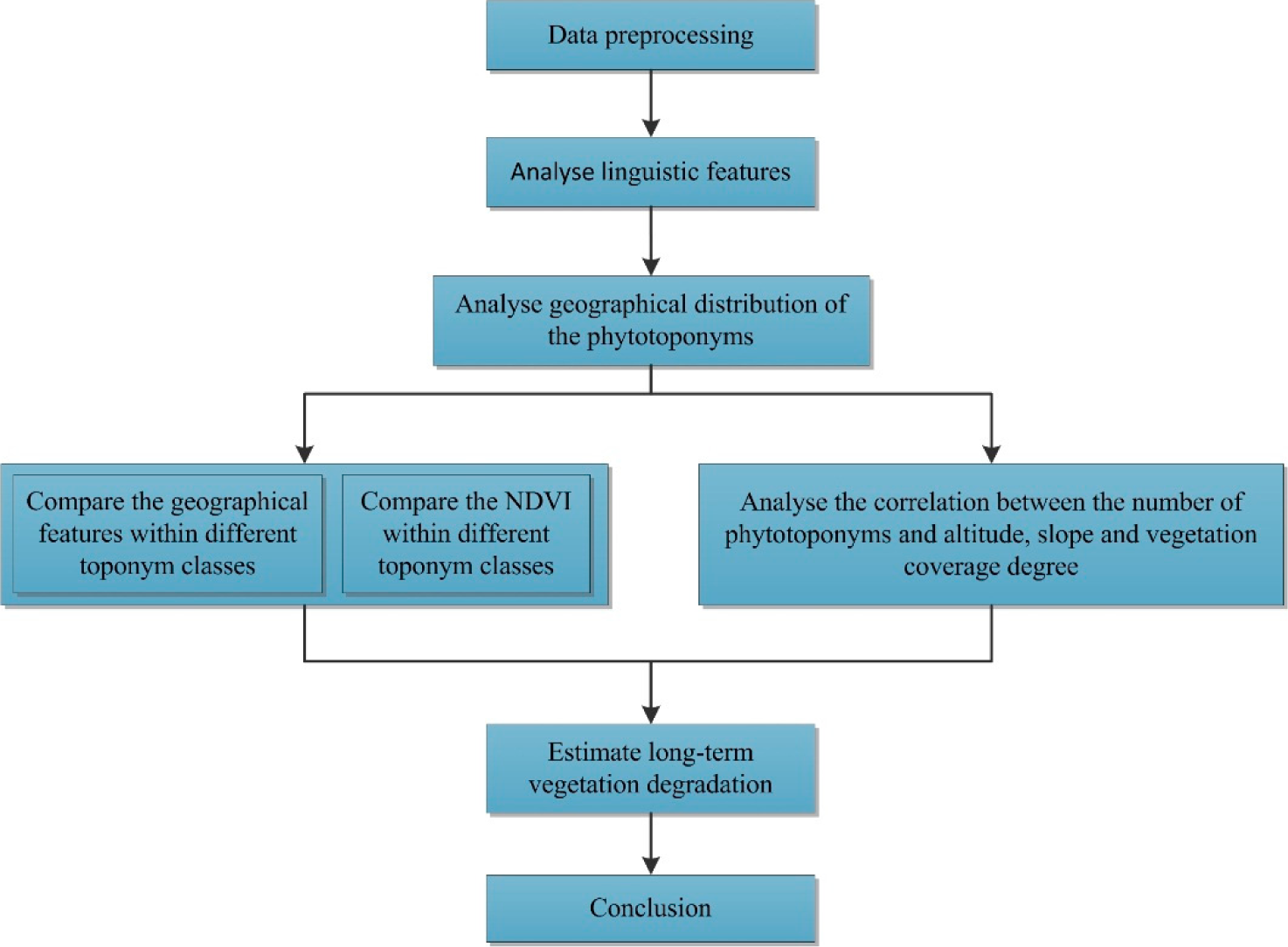
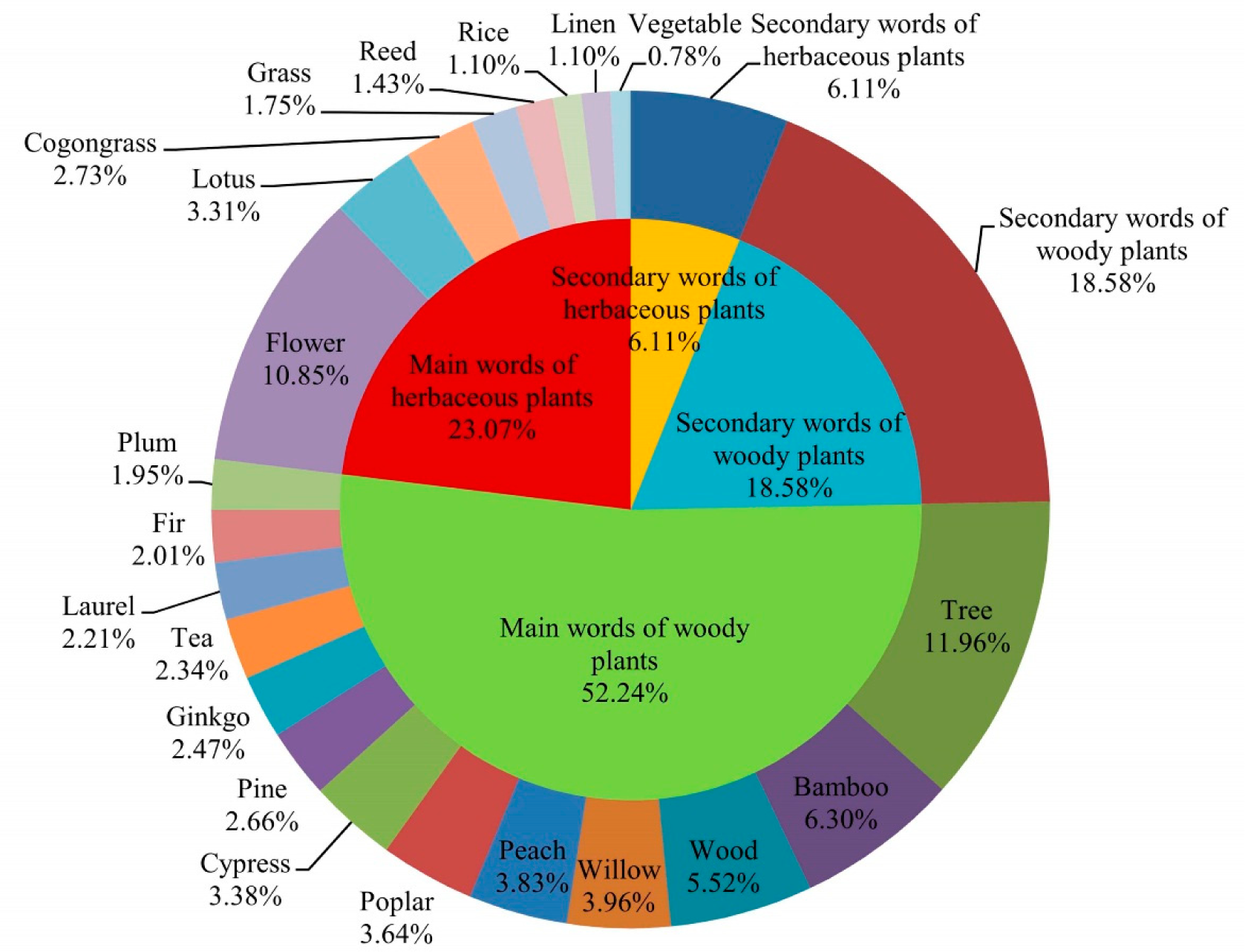
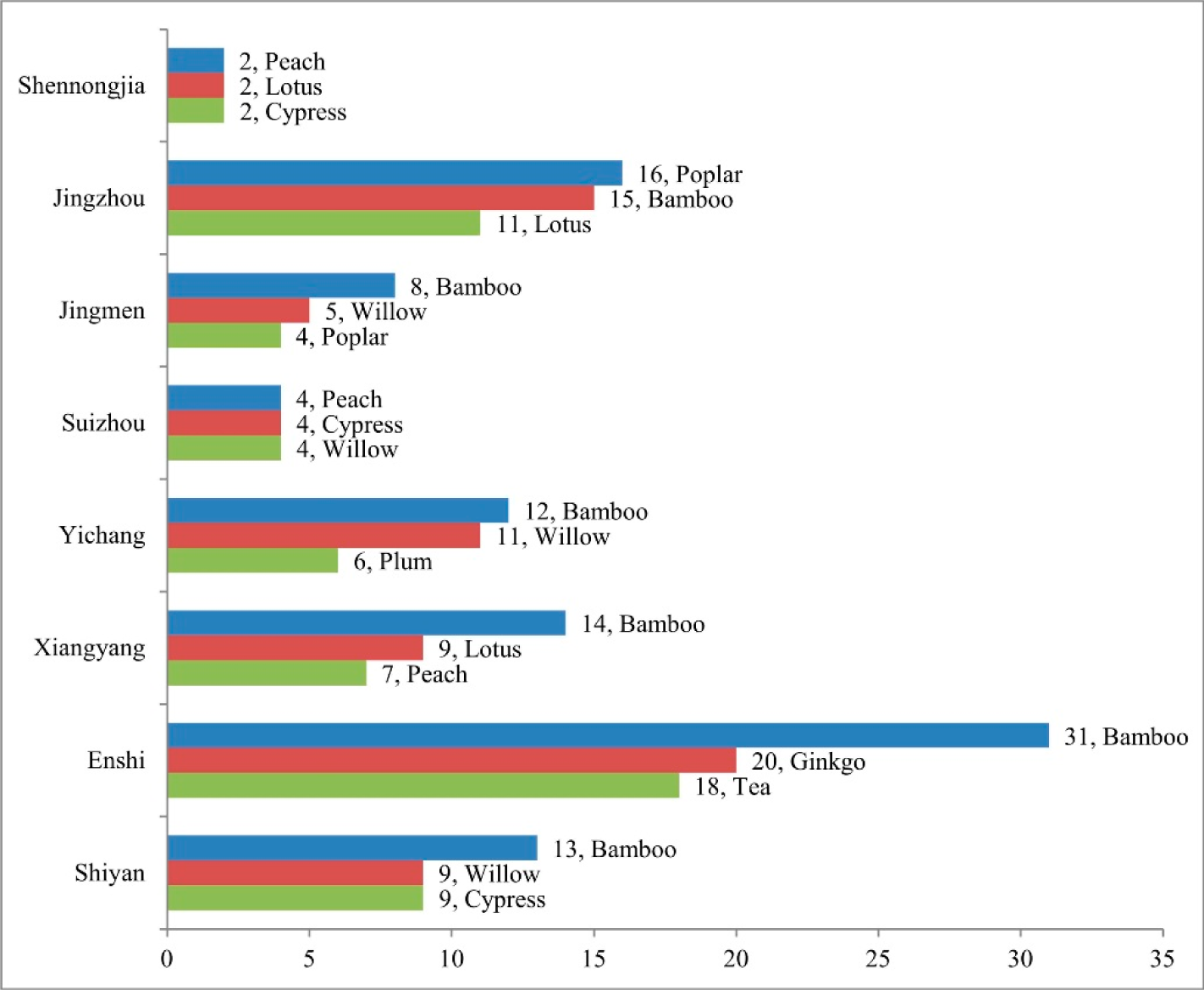
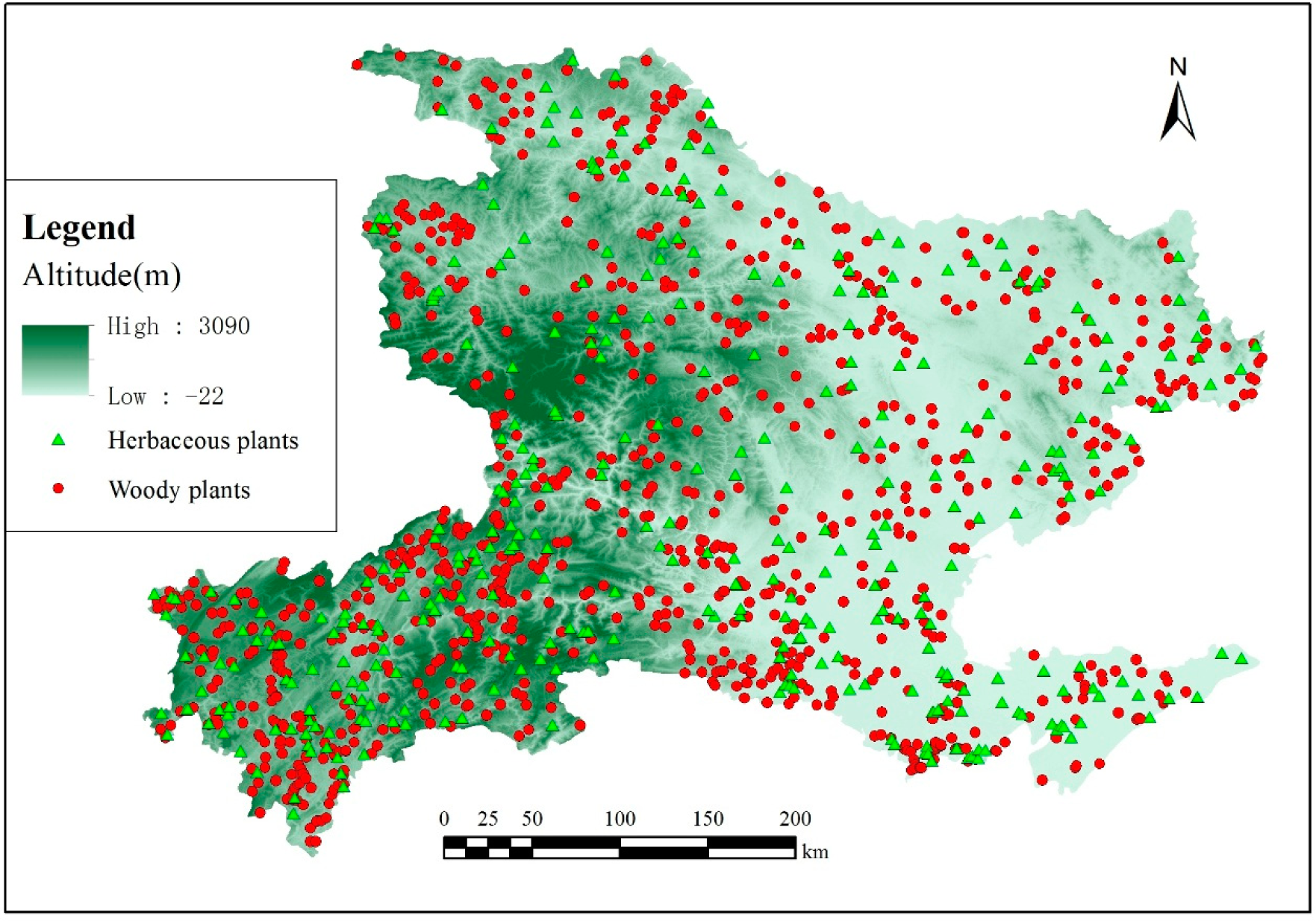

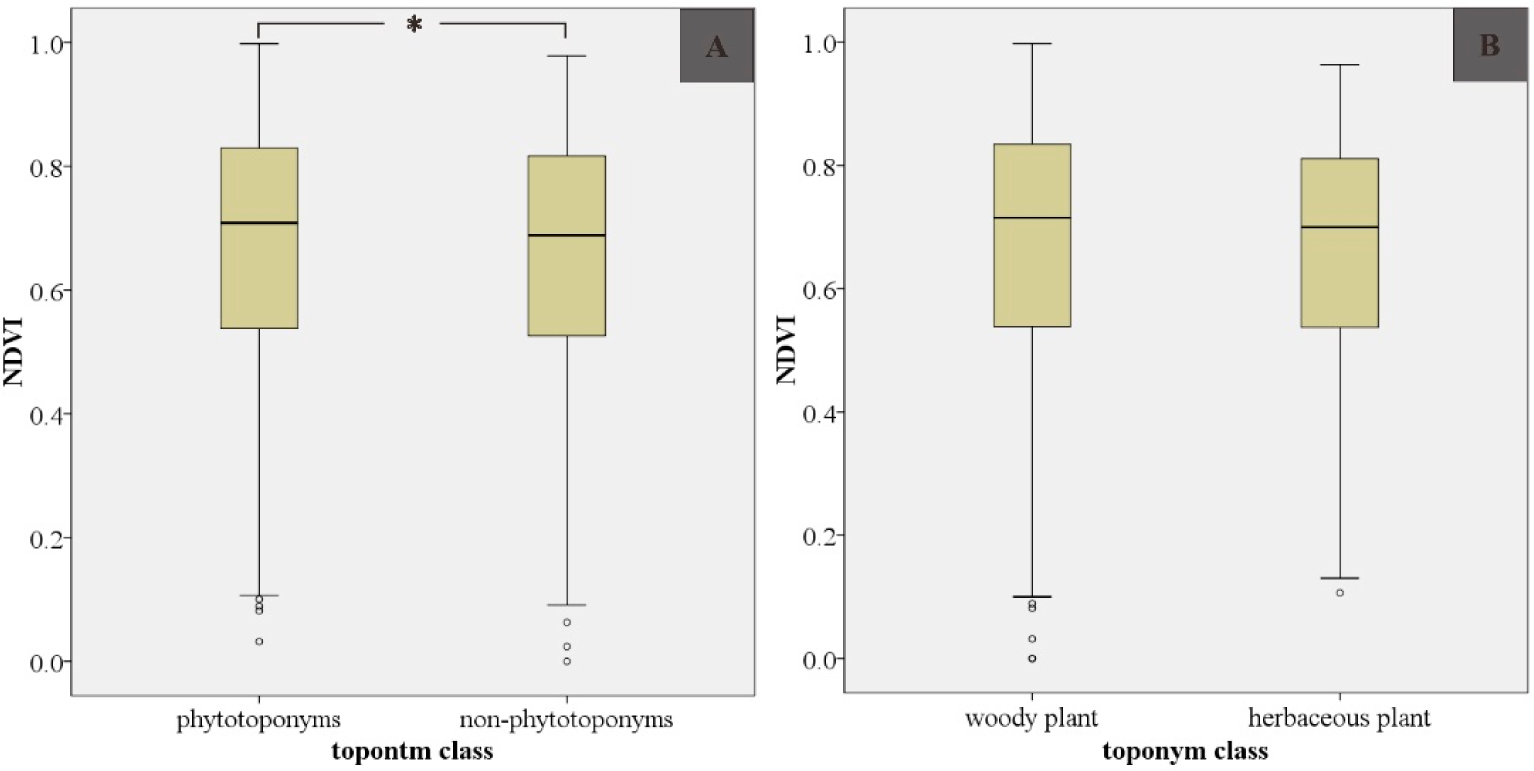

| Parameter | Description |
|---|---|
| Name | Names of the toponyms |
| Coordinate | X and Y coordinates |
| Vegetation coverage | NDVI |
| Topography | Altitude, slope and aspect |
| Classification | Number of phytotoponyms | Altitude (m) | Slope (°) | Vegetation coverage degree (%) |
|---|---|---|---|---|
| 1 | 0–10 | Less than 0 | Less than 2 | Less than 30 |
| 2 | 11–20 | 0–200 | 2–6 | 30–45 |
| 3 | 21–30 | 200–500 | 6–15 | 45–60 |
| 4 | 31–40 | 500–1000 | 15–25 | 60–75 |
| 5 | More than 40 | More than 1000 | More than 25 | More than 75 |
| Class | Main words | Frequency of occurrence | Ratio of occurrence (%) | Secondary words | Frequency of occurrence | Ratio of occurrence (%) |
|---|---|---|---|---|---|---|
| Woody plants | Tree | 184 | 11.96 | Chestnut | 286 | 18.58 |
| Bamboo | 97 | 6.30 | Paulownia | |||
| Wood | 85 | 5.52 | Pear | |||
| Willow | 61 | 3.96 | Vitex | |||
| Peach | 59 | 3.83 | Catalpa | |||
| Poplar | 56 | 3.64 | Walnut | |||
| Cypress | 52 | 3.38 | Wingceltis | |||
| Pine | 41 | 2.66 | Mulberry | |||
| Ginkgo | 38 | 2.47 | Robinia | |||
| Tea | 36 | 2.34 | Birch | |||
| Laurel | 34 | 2.21 | Tangerine | |||
| Fir | 31 | 2.01 | Maple | |||
| Plum | 30 | 1.95 | Oak, etc. | |||
| Herbaceous plants | Flower | 167 | 10.85 | Orchid | 94 | 6.11 |
| Lotus | 51 | 3.31 | Rattan | |||
| Cogongrass | 42 | 2.73 | Artemisia | |||
| Grass | 27 | 1.75 | Smartweed | |||
| Reed | 22 | 1.43 | Ginger | |||
| Rice | 17 | 1.10 | Medicine | |||
| Linen | 17 | 1.10 | Chrysanthemum | |||
| Vegetable | 12 | 0.78 | Wheat, etc. | |||
| Total | 1159 | 75.31 | 380 | 24.69 | ||
| City | Number of phytotoponyms | Proportion of phytotoponyms relative to the total toponyms (%) | Plant in the phytotoponym
| Characteristic plant of a city | ||
|---|---|---|---|---|---|---|
| No. | Unique plants | Frequency of occurrence | ||||
| Shiyan | 179 | 9.54 | 1 | Bamboo | 13 | Tea Papaya Rice |
| 2 | Willow | 9 | ||||
| 3 | Cypress | 9 | ||||
| 4 | Lotus | 7 | ||||
| 5 | Ginkgo | 6 | ||||
| 6 | Tea | 5 | ||||
| 7 | Papaya | 4 | ||||
| 8 | Palm | 3 | ||||
| 9 | Rice | 2 | ||||
| Enshi | 420 | 16.03 | 1 | Bamboo | 31 | Tea Paulownia Lacquer |
| 2 | Ginkgo | 20 | ||||
| 3 | Tea | 18 | ||||
| 4 | Cypress | 16 | ||||
| 5 | Plum | 12 | ||||
| 6 | Paulownia | 10 | ||||
| 7 | Chestnut | 9 | ||||
| 8 | Lacquer | 5 | ||||
| Xiangyang | 124 | 5.71 | 1 | Bamboo | 14 | Tea Willow |
| 2 | Lotus | 9 | ||||
| 3 | Peach | 7 | ||||
| 4 | Cypress | 6 | ||||
| 5 | Willow | 6 | ||||
| 6 | Pine | 5 | ||||
| 7 | Tea | 4 | ||||
| 8 | Plum | 3 | ||||
| Yichang | 154 | 11.16 | 1 | Bamboo | 12 | Tea Tangerine Walnut |
| 2 | Willow | 11 | ||||
| 3 | Plum | 6 | ||||
| 4 | Pine | 8 | ||||
| 5 | Laurel | 7 | ||||
| 6 | Poplar | 6 | ||||
| 7 | Nanmu | 5 | ||||
| 8 | Tangerine | 4 | ||||
| 9 | Tea | 3 | ||||
| 10 | Walnut | 1 | ||||
| Suizhou | 69 | 8.27 | 1 | Peach | 4 | Ginkgo |
| 2 | Cypress | 4 | ||||
| 3 | Willow | 4 | ||||
| 4 | Plum | 3 | ||||
| 5 | Ginkgo | 3 | ||||
| 6 | Wingceltis | 3 | ||||
| 7 | Saponin | 2 | ||||
| Jingmen | 87 | 7.79 | 1 | Bamboo | 8 | |
| 2 | Willow | 5 | ||||
| 3 | Poplar | 4 | ||||
| 4 | Jujube | 4 | ||||
| 5 | Lotus | 4 | ||||
| 6 | Chestnut | 3 | ||||
| 7 | Catalpa | 3 | ||||
| 8 | Vitex | 2 | ||||
| Jingzhou | 211 | 8.16 | 1 | Poplar | 16 | Lotus |
| 2 | Bamboo | 15 | ||||
| 3 | Lotus | 11 | ||||
| 4 | Reed | 9 | ||||
| 5 | Willow | 8 | ||||
| 6 | Fir | 6 | ||||
| 7 | Laurel | 6 | ||||
| 8 | Oak | 3 | ||||
| 9 | Plum | 2 | ||||
| 10 | Water chestnut | 2 | ||||
| Shennongjia | 15 | 20.55 | 1 | Peach | 2 | |
| 2 | Lotus | 2 | ||||
| 3 | Cypress | 2 | ||||
| Altitude | Slope | Aspect | |
|---|---|---|---|
| Mann-Whitney U | 741,693.500 | 752,102 | 783,214 |
| Wilcoxon W | 1,523,568.500 | 1,533,977 | 1,565,089 |
| Z | −2.490 | −1.927 | −0.202 |
| Asymptotic significance (double-sided) | 0.013 | 0.054 | 0.840 |
| Altitude | Slope | Aspect | |
|---|---|---|---|
| Mann-Whitney U | 154,768.500 | 148,425.500 | 157,966.000 |
| Wilcoxon W | 220,109.500 | 213,766.500 | 561,617.000 |
| Z | −1.255 | −2.353 | −0.707 |
| Asymptotic significance (double-sided) | 0.210 | 0.019 | 0.480 |
| NDVI | |
|---|---|
| Mann-Whitney U | 751,198.500 |
| Wilcoxon W | 1,533,073.500 |
| Z | −1.966 |
| Asymptotic significance (double-sided) | 0.049 |
| NDVI | |
|---|---|
| Mann-Whitney U | 157,480.000 |
| Wilcoxon W | 222,821.000 |
| Z | −0.790 |
| Asymptotic significance (double-sided) | 0.430 |
| Altitude (m) | Number of phytotoponyms
| P(yi) | ||||
|---|---|---|---|---|---|---|
| Less than 10 | 10–20 | 20–30 | 30–40 | More than 40 | ||
| Less than 0 | 0 | 0 | 0 | 0 | 0 | 0 |
| 0–200 | 4/46 | 6/46 | 5/46 | 3/46 | 2/46 | 20/46 |
| 200–500 | 1/46 | 3/46 | 1/46 | 0 | 0 | 5/46 |
| 500–1000 | 0 | 3/46 | 6/46 | 1/46 | 1/46 | 11/46 |
| More than 1000 | 0 | 3/46 | 0 | 2/46 | 5/46 | 10/46 |
| P(xi) | 5/46 | 15/46 | 12/46 | 6/46 | 8/46 | 1 |
| Slope (°) | Number of phytotoponyms
| P(yi) | ||||
|---|---|---|---|---|---|---|
| Less than 10 | 10–20 | 20–30 | 30–40 | More than 40 | ||
| Less than 2 | 2/46 | 4/46 | 2/46 | 0 | 1/46 | 9/46 |
| 2–6 | 2/46 | 1/46 | 3/46 | 3/46 | 1/46 | 10/46 |
| 6–15 | 1/46 | 4/46 | 1/46 | 1/46 | 0 | 7/46 |
| 15–25 | 0 | 5/46 | 6/46 | 2/46 | 6/46 | 19/46 |
| More than 25 | 0 | 1/46 | 0 | 0 | 0 | 1/46 |
| P(xi) | 5/46 | 15/46 | 12/46 | 6/46 | 8/46 | 1 |
| Vegetation coverage degree (%) | Number of phytotoponyms
| P(yi) | ||||
|---|---|---|---|---|---|---|
| Less than 10 | 10–20 | 20–30 | 30–40 | More than 40 | ||
| Less than 30 | 1/46 | 2/46 | 0 | 0 | 0 | 3/46 |
| 30–45 | 3/46 | 1/46 | 2/46 | 0 | 0 | 6/46 |
| 45–60 | 0 | 6/46 | 2/46 | 1/46 | 1/46 | 10/46 |
| 60–75 | 1/46 | 2/46 | 3/46 | 2/46 | 4/46 | 12/46 |
| More than 75 | 0 | 4/46 | 5/46 | 3/46 | 3/46 | 15/46 |
| P(xi) | 5/46 | 15/46 | 12/46 | 6/46 | 8/46 | 1 |
| Number of phytotoponyms | Altitude | Slope | Vegetation coverage degree | |
|---|---|---|---|---|
| Information entropy | 2.203 | 1.843 | 1.999 | 2.152 |
| Altitude | Slope | Vegetation coverage degree | |
|---|---|---|---|
| Number of phytotoponyms | 0.0916 | 0.0786 | 0.0897 |
| Number of woody plant toponyms | 0.0703 | 0.0550 | 0.0651 |
| Number of herbaceous plant toponyms | 0.0455 | 0.0370 | 0.0295 |
| County | Vegetation degradation ratio (%) | Number of vegetation degradation toponyms | Number of phytotoponyms | Number of toponyms | The proportion of phytotoponyms (%) |
|---|---|---|---|---|---|
| Jiangling | 40.00 | 4 | 10 | 222 | 4.5 |
| Xiangcheng district | 40.00 | 4 | 10 | 172 | 5.81 |
| Gucheng | 30.77 | 4 | 13 | 290 | 4.48 |
| Yidu | 26.67 | 4 | 15 | 145 | 10.34 |
| Yicheng | 25.00 | 2 | 8 | 206 | 3.88 |
| Changyang | 21.74 | 5 | 23 | 159 | 14.47 |
| Xuanen | 20.00 | 9 | 45 | 284 | 15.49 |
| Enshi | 17.07 | 7 | 41 | 206 | 19.9 |
| Hefeng | 16.13 | 5 | 31 | 201 | 14.93 |
| Nanzhang | 15.00 | 3 | 20 | 304 | 6.58 |
| Gongan | 15.00 | 3 | 20 | 374 | 5.35 |
| Jingzhou municipal district | 15.00 | 3 | 20 | 321 | 6.23 |
| Danjiangkou | 14.81 | 4 | 27 | 246 | 10.98 |
| Laohekou | 12.50 | 1 | 8 | 258 | 3.1 |
| Zigui | 12.50 | 2 | 16 | 193 | 8.29 |
| Zhijiang | 12.50 | 2 | 16 | 214 | 7.48 |
| Yiling district | 11.76 | 2 | 17 | 223 | 7.62 |
| Jianshi | 11.59 | 8 | 69 | 393 | 17.56 |
| Xianfeng | 11.54 | 6 | 52 | 289 | 17.99 |
| Yun | 10.00 | 3 | 30 | 350 | 8.57 |
| Xiangfan municipal district | 10.00 | 2 | 20 | 829 | 2.41 |
| Jingshan | 9.09 | 3 | 33 | 430 | 7.67 |
| Dangyang | 8.33 | 1 | 12 | 185 | 6.49 |
| Yunxi | 8.00 | 2 | 25 | 341 | 7.33 |
| Songzi | 7.84 | 4 | 51 | 473 | 10.78 |
| Fang | 7.41 | 2 | 27 | 288 | 9.38 |
| Jingmen municipal district | 6.90 | 2 | 29 | 577 | 5.03 |
| Lichuan | 5.88 | 5 | 85 | 585 | 14.53 |
| Laifeng | 5.71 | 2 | 35 | 196 | 17.86 |
| Yichang municipal district | 5.00 | 1 | 20 | 510 | 3.92 |
| Badong | 5.00 | 3 | 60 | 491 | 12.22 |
| Baokang | 4.55 | 1 | 22 | 279 | 7.89 |
| Zaoyang | 4.17 | 1 | 24 | 566 | 4.24 |
| Zhongxiang | 4.00 | 1 | 25 | 546 | 4.58 |
| Suizhou | 2.94 | 1 | 34 | 541 | 6.28 |
| Guangshui | 2.86 | 1 | 35 | 401 | 8.73 |
| Shishou | 1.82 | 1 | 55 | 802 | 6.86 |
| Honghu | 0 | 0 | 29 | 494 | 5.87 |
| Zhuxi | 0 | 0 | 36 | 292 | 12.33 |
| Shiyan municipal district | 0 | 0 | 11 | 168 | 6.55 |
| Zhushan | 0 | 0 | 23 | 264 | 8.71 |
| Shennongjia | 0 | 0 | 15 | 73 | 20.55 |
| Xingshan | 0 | 0 | 12 | 96 | 12.5 |
| Yuanan | 0 | 0 | 5 | 46 | 10.87 |
| Wufeng | 0 | 0 | 19 | 109 | 17.43 |
| Jianli | 0 | 0 | 26 | 833 | 3.12 |
| Total | —— | 114 | 1259 | 15465 | —— |
| Average | 9.05 | 2.48 | 27 | 336 | 8.04 |
© 2015 by the authors; licensee MDPI, Basel, Switzerland This article is an open access article distributed under the terms and conditions of the Creative Commons Attribution license (http://creativecommons.org/licenses/by/4.0/).
Share and Cite
Shi, G.; Ren, F.; Du, Q.; Gao, N. Phytotoponyms, Geographical Features and Vegetation Coverage in Western Hubei, China. Entropy 2015, 17, 984-1006. https://doi.org/10.3390/e17030984
Shi G, Ren F, Du Q, Gao N. Phytotoponyms, Geographical Features and Vegetation Coverage in Western Hubei, China. Entropy. 2015; 17(3):984-1006. https://doi.org/10.3390/e17030984
Chicago/Turabian StyleShi, Guanghui, Fu Ren, Qingyun Du, and Nan Gao. 2015. "Phytotoponyms, Geographical Features and Vegetation Coverage in Western Hubei, China" Entropy 17, no. 3: 984-1006. https://doi.org/10.3390/e17030984






